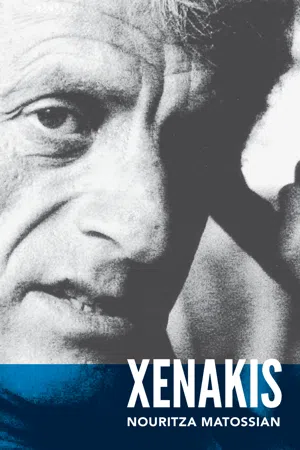Xenakis
About this book
Iannis Xenakis revolutionized post-war music more forcefully than any other 20th-century composer. A Resistance leader in World War II, he escaped from Greece to Paris under sentence of death. He became one of Le Corbusier's chief architects, and a pioneer of the computer age in music and the arts. Milan Kundera called him 'the prophet of insensibility'.
Xenakis harnessed chaos theory and invented 'stochastic music'. He freed the sound spectrum from western scales and based music on natural principles. He combined architecture, light and sound in a radical new art form to create a boundless aesthetic in music. Shunned by contemporaries, this influential thinker created over 150 vast compositions imbued with elemental passion, and brilliantly reinvented the landscape of music forever.
Since it was first published in 1981, Nouritza Matossian's perceptive book on Xenakis has helped students, musicians and audiences appreciate his music. She shares his Greek culture and interest in philosophy, and has chronicled vital discoveries in his work. A reserved man, he spoke frankly to her about his mysterious methods of composition, and his relationships with Varèse, Messiaen, Le Corbusier and Boulez.
Xenakis' prophecy that computers, science and art would converge makes this book essential reading for understanding the digital revolution of our time. Matossian's well-researched biography is an unrivalled classic on modern music. This new edition includes an unpublished interview and essays, and is illustrated with musical and architectural sketches, scores and recently released archival photos.
----
The New Yorker • 'An intelligent book.'
The Independent • 'A revealing contribution to the history of post-war avant-garde.'
Le Monde • 'An accessible biography … and an excellent introduction.'
Library Journal • 'An authoritative choice. Fascinating. Highly recommended.'
Journal de Genève • 'Written only after Matossian tamed the savage inventor of
stochastic music.'
Perspectives of New Music • ' Xenakis is a work that has a truly wide range of appeal … an asset to any library's collection on contemporary music.'
Frequently asked questions
- Essential is ideal for learners and professionals who enjoy exploring a wide range of subjects. Access the Essential Library with 800,000+ trusted titles and best-sellers across business, personal growth, and the humanities. Includes unlimited reading time and Standard Read Aloud voice.
- Complete: Perfect for advanced learners and researchers needing full, unrestricted access. Unlock 1.4M+ books across hundreds of subjects, including academic and specialized titles. The Complete Plan also includes advanced features like Premium Read Aloud and Research Assistant.
Please note we cannot support devices running on iOS 13 and Android 7 or earlier. Learn more about using the app.
Information
Table of contents
- Credits
- Preface to the Second Edition
- Introduction
- Chapter one | In Childhood and Resistance
- Chapter two | Awakening in Paris
- Chapter three | The Eruptive Unconscious
- Chapter four | Stochastic Music
- Chapter five | The Philips Pavilion
- Chapter six | The Break with Le Corbusier
- Chapter seven | Formalizing Music
- Chapter eight | The Way of Truth and the Way of Seeming
- Chapter nine | Symmetry under Cover
- Chapter ten | Total Theatre
- Chapter eleven | The Polytopes
- Chapter twelve | Branching Out
- Essay | Artisan of Nature
- Of Being and Necessity
- Afterword | Visible and Invisible Universes
- In memoriam | A Man to Melt the Icecaps
- List of Compositions
- Architectural Projects
- Bibliography
